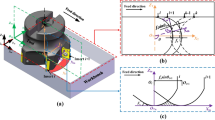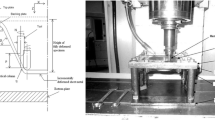Abstract
Surface roughness morphology seriously restricts workpiece interface contact performance, and therefore it is necessary to remove the fog of relationships between morphology parameters and contact stress (CS). To study the issue, use correlation analysis and BP network to set up correlation mapping model, thereafter introduce global sensitivity analysis Morris (qualitative) and Sobol (quantitative) to get “main influence parameters (MIP)”. Afterwards, construct a optimal nonlinear regression model between MIP and CS in line with complete polynomial and the idea of permutation and combination. Finally, analyze MIP influence path on CS from statistical path analysis. The paper main contributions are as follows: 1. From the perspective of theoretical analysis, a reasonable method to select parameters about CS performance characterization is proposed to avoid the empirical selection errors; 2. Correlation relationships bridge is built between MIP and CS, with quantitative influence way of parameters on contact stress studied and clarified.
Similar content being viewed by others
References
B. Hu et al., Nonlinear tribo-dynamic model and experimental verification of a spur gear drive under loss-of-lubrication condition, Mechanical Systems and Signal Processing, 153 (2021) 107509.
B. Zhang et al., Ratchetting-multiaxial fatigue damage analysis in gear rolling contact considering tooth surface roughness, Wear, 428 (2019) 137–146.
R. Xiong et al., Experimental study on surface morphology of ultra-precision turning, Manufacturing Technology and Machine Tool, 7 (2020) 72–75.
H. Liu et al., Effects of lubrication on gear performance: a review, Mechanism and Machine Theory, 145 (2020) 103701.
Y. Zhou et al., Influence of surface roughness on the friction property of textured surface, Advances in Mechanical Engineering, 7(2) (2015) 758577100.
J. Wang and Q. Liang, Influence of surface topography on friction and wear properties of cold die steel, Surface Technology, 48(10) (2019) 206–213.
B. Zhang, S. Li and Q. Zhang, Effect of surface micromorphology on the deformation and bonding quality of stainless steel/carbon steel during hot isostatic pressing, Journal of Mechanical Engineering, 55(10) (2019) 62–69.
B. He et al., Three-dimensional surface roughness characterization and application, Optics and Precision Engineering, 26(8) (2018) 1994–2011.
C. Liu and L. Zhang, Selection and effect of parts surface roughness, Modern Manufacturing Engineering, 2 (2004) 114–115.
H. Li, X. Jiang and Z. Li, Summary of development of 3D surface function evaluation technology, Tool Engineering, 2 (2002) 8–11.
C. Wu, Research progress of rough surface contact, Advances in Mechanics, 1 (1991) 96–108.
J. A. Greenwood, C. Putignano and M. Ciavarella, A Greenwood and Williamson theory for line contact, Wear, 270(3–4) (2011) 332–334.
B. N. J. Persson, Contact mechanics for randomly rough surfaces: on the validity of the method of reduction of dimensionality, Tribology Letters, 58(1) (2015) 1–4.
L. Lai, C. Gao and J. Huang, Advances on sliding frictional contact models of rough surfaces, Chinese Journal of Construction Machinery, 9(2) (2011) 134–138.
L. Wei et al., Progress of study on contact models of rough surfaces, Lubrication Engineering, 34(7) (2009) 112–117.
A. Brandt and A. A. Lubrecht, Multilevel matrix multiplication and fast solution of integral equations, Journal of Computational Physics, 90(2) (1990) 348–370.
Z. Wang et al., An efficient numerical method with a parallel computational strategy for solving arbitrarily shaped inclusions in elastoplastic contact problems, Journal of Tribology, 135(3) (2013) 031401.
Y. Wen et al., A new elliptical microcontact model considering elastoplastic deformation, Proceedings of the Institution of Mechanical Engineers, Part J: Journal of Engineering Tribology, 232(11) (2018) 1352–1364.
Y. Wen et al., A reconstruction and contact analysis method of three-dimensional rough surface based on ellipsoidal asperity, Journal of Tribology, 142(4) (2020) 041502.
D. Draganovská et al., The study of parameters of surface roughness by the correlation analysis, Materials Science Forum, 818 (2015) 15–18.
Q. Qi et al., A correlational study of areal surface texture parameters on some typical machined surfaces, Procedia CIRP, 27 (2015) 149–154.
W. P. Dong and K. J. Stout, An integrated approach to the characterization of surface wear. I: qualitative characterization, Wear, 81 (1995) 700–716.
Á. Czifra and S. Horváth, Complex microtopography analysis in sliding friction of steel-ferodo material pair, Meccanica, 46(3) (2011) 609–616.
N. Bulaha, Analysis of service properties of cylindrically ground surfaces, using Standard ISO 25178–2:2012. surface texture parameters, Proc. of the International Scientific and Practical Conference, Rezekne, Latvia (2015) 16–21.
ISO Standard 25178-2:2012, Geometrical Product Specifications (GPS)-Surface Texture: Area, Part 2: Terms, Definitions and Surface Texture Parameters, International Organization for Standardization, Geneva, Switzerland (2012).
L. Vincent and P. Soille, Watersheds in digital spaces: an efficient algorithm based on immersion simulations, IEEE Transactions on Pattern Analysis and Machine Intelligence, 6 (1991) 583–598.
M. Augasta and T. Kathirvalavakumar, Pruning algorithms of neural networks-a comparative study, Open Computer Science, 3(3) (2013) 105–115.
H. Zhang and D. Wang, An improved BP neural network based on CPA, Journal of Southwest University (Natural Science Edition), 38(3) (2016) 165–170.
M. D. Morris, Factorial sampling plans for preliminary computational experiments, Technometrics, 33(2) (1991) 161–174.
F. Campolongo, J. Cariboni and A. Saltelli, An effective screening design for sensitivity analysis of large models, Environmental Modelling and Software, 22(10) (2007) 1509–1518.
I. M. Sobol, On sensitivity estimation for nonlinear mathematical models, Matematicheskoe Modelirovanie, 2(1) (1990) 112–118.
R. Chen et al., A computational inverse technique to determine the dynamic constitutive model parameters of concrete, Computers, Materials, and Continua, 25(2) (2011) 135–157.
Y. Kai et al., Qualitative and quantitative analysis of nonlinear dynamics by the complete discrimination system for polynomial method, Chaos, Solitons and Fractals, 141 (2020) 110314.
C. Lleras, Path analysis, Encyclopedia of Social Measurement, 3(1) (2015) 25–30.
X. Song et al., Sensitivity analysis of hydrological model parameters using a statistical theory approach, Advances in Water Science, 23(5) (2012) 642–649.
A. N. Spiess and N. Neumeyer, An evaluation of R2 as an inadequate measure for nonlinear models in pharmacological and biochemical research: a Monte Carlo approach, BMC Pharmacology, 10(1) (2010) 1–11.
R. L. Sapra, Using R2 with caution, Current Medicine Research and Practice, 4(3) (2014) 130–134.
Acknowledgments
This work was funded by National Key R&D Program of China (Grant No. 2019YFB2004700) and National Natural Science Foundation of China (NSFC) through Grants No. 51705142.
Author information
Authors and Affiliations
Corresponding author
Additional information
Jinyuan Tang received his Ph.D. degree in Mechanical Engineering from Central South University, Changsha, China. He joined the State Key Laboratory of High Performance Complex Manufacturing at Central South University since 1982. His research areas cover intelligent manufacturing of high performance devices, and research on design theory of high performance power transmission device.
Yang Duo graduated from Wuhan University of Technology with a bachelor’s degree in 2018. Now he is a Ph.D. Student in the State Key Laboratory of High Performance Complex Manufacturing at Central South University, Changsha, China. He is mainly engaged in the relationship between surface morphology and contact properties and his research also coveres tribology, wear.
Wei Zhou received his M.S. and Ph.D. degrees in Mechanical Engineering from Central South University, China, in 2011 and 2016, respectively. He joined the Hunan Provincial Key Laboratory of High Efficiency and Precision Machining of Difficult-to-Cut Material at Hunan University of Science and Technology since 2016. His research areas cover tribology and structural fatigue and fracture.
Yuqin Wen received his Bachelor’s degree in Mechanical Engineering from Central South University, Changsha, China, in 2015. Then, he was a Ph.D. student in the State Key Laboratory of High Performance Complex Manufacturing at the same university. His research areas cover tribology and structural fatigue and fracture.
Rights and permissions
About this article
Cite this article
Yang, D., Tang, J., Zhou, W. et al. Comprehensive study of relationships between surface morphology parameters and contact stress. J Mech Sci Technol 35, 4975–4985 (2021). https://doi.org/10.1007/s12206-021-1016-z
Received:
Revised:
Accepted:
Published:
Issue Date:
DOI: https://doi.org/10.1007/s12206-021-1016-z




